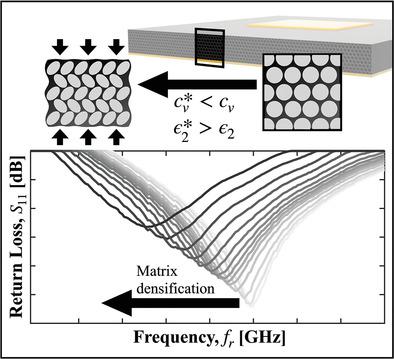当前位置:
X-MOL 学术
›
Adv. Mater. Technol.
›
论文详情
Our official English website, www.x-mol.net, welcomes your
feedback! (Note: you will need to create a separate account there.)
Dielectric Elastomer Architectures with Strain-Tunable Permittivity
Advanced Materials Technologies ( IF 6.4 ) Pub Date : 2022-07-30 , DOI: 10.1002/admt.202200296 Maura R. O'Neill 1 , Deanna Sessions 2 , Nitesh Arora 3 , Vincent W. Chen 4 , Abigail Juhl 4 , Gregory H. Huff 2 , Stephan Rudykh 3 , Robert F. Shepherd 1 , Philip R. Buskohl 4
Advanced Materials Technologies ( IF 6.4 ) Pub Date : 2022-07-30 , DOI: 10.1002/admt.202200296 Maura R. O'Neill 1 , Deanna Sessions 2 , Nitesh Arora 3 , Vincent W. Chen 4 , Abigail Juhl 4 , Gregory H. Huff 2 , Stephan Rudykh 3 , Robert F. Shepherd 1 , Philip R. Buskohl 4
Affiliation

|
Flexible hybrid electronic (FHE) materials and devices exploit the interaction of mechanical and electromagnetic properties to operate in new form factors and loading environments, which are key for advancing wearable sensors, flexible antennas, and soft robotic skin technologies. Dielectric elastomer (DE) architectures offer a novel substrate material for this application space as they are a class of strain-tolerant and programmable metamaterials that derive their mechanical and dielectric properties from their architecture. Due to their hyperelasticity, dielectric elastomers can leverage reversible finite deformation to physically reconfigure their internal architecture to repeatedly tune their material behavior. Here a combined computational and experimental study of two dielectric elastomer architectures, based on square and hexagonal unit cell periodicities are presented. A shift in effective permittivity is observed due to the relative increase in matrix volume and the rearrangement of the electric field distribution in the cells. Additive fabrication allows rapid unit cell geometry customization for tuning the electromechanical response of the architectures. Effective permittivity shifts Δε2 > 0.7 under compressive strains of 35% are observed. The practical utility of this strain-tunable permittivity is demonstrated in a microstrip patch antenna, which exhibits shifts in resonance frequency greater than 110 MHz when the dielectric elastomer substrate is compressed.
中文翻译:

具有应变可调介电常数的介电弹性体架构
柔性混合电子 (FHE) 材料和设备利用机械和电磁特性的相互作用在新的外形和负载环境中运行,这是推进可穿戴传感器、柔性天线和软机器人皮肤技术的关键。介电弹性体 (DE) 架构为该应用领域提供了一种新型的基板材料,因为它们是一类耐应变和可编程的超材料,从其架构中获得了机械和介电特性。由于它们的超弹性,介电弹性体可以利用可逆的有限变形来物理重新配置其内部结构,以反复调整其材料行为。这里是对两种介电弹性体结构的计算和实验研究,提出了基于正方形和六边形晶胞的周期性。由于基质体积的相对增加和细胞中电场分布的重新排列,观察到有效介电常数的变化。增材制造允许快速定制晶胞几何形状,以调整架构的机电响应。有效介电常数变化 Δ 在 35% 的压缩应变下观察到ε 2 > 0.7。这种应变可调介电常数的实用性在微带贴片天线中得到了证明,当介电弹性体基板被压缩时,其谐振频率的变化大于 110 MHz。
更新日期:2022-07-30
中文翻译:

具有应变可调介电常数的介电弹性体架构
柔性混合电子 (FHE) 材料和设备利用机械和电磁特性的相互作用在新的外形和负载环境中运行,这是推进可穿戴传感器、柔性天线和软机器人皮肤技术的关键。介电弹性体 (DE) 架构为该应用领域提供了一种新型的基板材料,因为它们是一类耐应变和可编程的超材料,从其架构中获得了机械和介电特性。由于它们的超弹性,介电弹性体可以利用可逆的有限变形来物理重新配置其内部结构,以反复调整其材料行为。这里是对两种介电弹性体结构的计算和实验研究,提出了基于正方形和六边形晶胞的周期性。由于基质体积的相对增加和细胞中电场分布的重新排列,观察到有效介电常数的变化。增材制造允许快速定制晶胞几何形状,以调整架构的机电响应。有效介电常数变化 Δ 在 35% 的压缩应变下观察到ε 2 > 0.7。这种应变可调介电常数的实用性在微带贴片天线中得到了证明,当介电弹性体基板被压缩时,其谐振频率的变化大于 110 MHz。































 京公网安备 11010802027423号
京公网安备 11010802027423号